| Photojournal
- 12 June
2005
Taking
care of the kids
|
The 12th of June was
a Sunday and after rising late, I decided to head over to Burnaby
Lake for the afternoon, even though it was overcast. It was my
last day of freedom; I was returning to work on the morrow.
On the drive over to
the lake, I noticed a cute little striped spider crawling around
on the inside of my windshield. I wondered a little about how
he had gotten there (had he hitched a ride on my clothing or camera
bags?) and resolved to get some photos of him after I got to the
park. About five minutes later, I arrived and parked at the Piper
Spit entrance. My spider was still up on the windshield. Here's
the little guy.
|
|
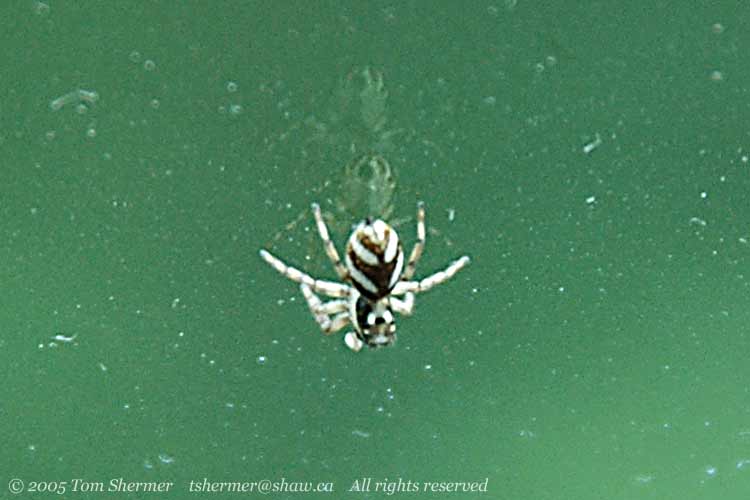 |
|
I guess you can tell
that my windshield is a little dusty in that shot, and you'll
be happy to know that I've cleaned it since then. What I like
about that shot is the two reflections of the spider in the glass.
This guy is a Jumping
Spider. "Jumping Spider" is actually a name given to
any member of the family Salticidae.
I'll digress a bit
here to talk about modern phylogenetic biology ("biological
classification"). Linnaeus' old kingdom-phylum-class-order-family-genus-species
system of classification has been replaced with a much more
flexible system, with levels of subdivision inserted wherever
it seems appropriate, genetically speaking. Not all of these new
levels of subdivision have names, not every group of organisms
has a name, and if you divide a group into subgroups, those subgroups
don't all have to be at the same level.
For instance, the
Salticidae (Jumping Spiders) contains three things: the group
Lyssomaninae (containing six genera), the group Spartaeinae (containing
15 genera), and the "Salticinae Division". The Salticinae
Division contains the group Hisponinae, two unnamed groups of
two subgroups each, and a large group called the Unidentates.
The Unidentates contains three groups directly, an unnamed group
of two subgroups, and a "miscellaneous" group, and a
subgroup called the "Free-embolus Group". And the Free-embolus
Group itself contains four groups and a "miscellaneous"
group. The point of all this is that there are many further levels
of grouping and subdivision here than I learned in high school,
and all this is just between family and genus! But such is the
power of DNA and anatomy studies, I guess.
However, one nice thing
is that, in case you learned the old Linnaeic system, families
are still bigger groups than genera and smaller groups than orders,
and genera (the plural of "genus") are still groups
of closely-related species.
If you're interested
in this kind of stuff, you may want to have a look at the Tree
of Life, a web project that documents the current state of phylogenetic
biology. It can be found at http://tolweb.org.
The page for the Salticidae is at http://tolweb.org/tree?group=Salticidae,
where you'll see a visual representation of the groupings I described
two paragraphs ago (along with a very handsome Jumping Spider,
and lots of other interesting information).
Okay, so I've got a
Jumping Spider. Jumping spiders don't build webs; they hunt for
food (insects) during the day. They are reputed to have keen eyesight,
good reflexes, and can jump 50 times their body length to catch
prey. This guy's body length was about a centimeter, so he'd be
able to jump at least half a meter, which is pretty impressive
considering how skinny his legs are.
One last really nice
thing about Jumping Spiders is that a world expert on them, the
guy who maintains the Tree of Life section about them, lives in
Vancouver. He's a fellow named Wayne, who works at the University
of British Columbia. I sent Wayne my photos and he told me that
the particular spider I have here is a Salticus scenicus. It's
in the unnamed group of two genera that's in the Unidentates,
which is in the Salticinae Division.
Anyhow, here's another
shot of my scenic little passenger, after he jumped down to the
dashboard. I took a few shots like this one, and then herded him
onto a piece of paper and let him off on the ground beside my
car.
|
|
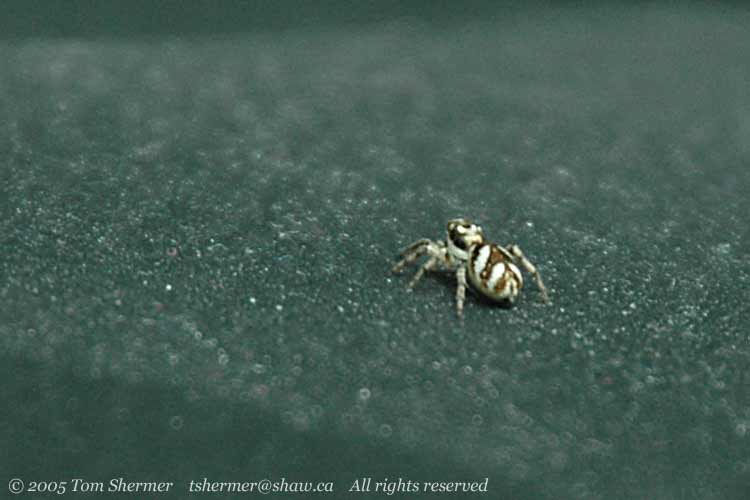 |
| Then I headed
in to the park. For the first time that I can remember, the Nature
House was open. The Nature House is a little one-room mini-museum
set up to educate and entertain any children who come by. |
|
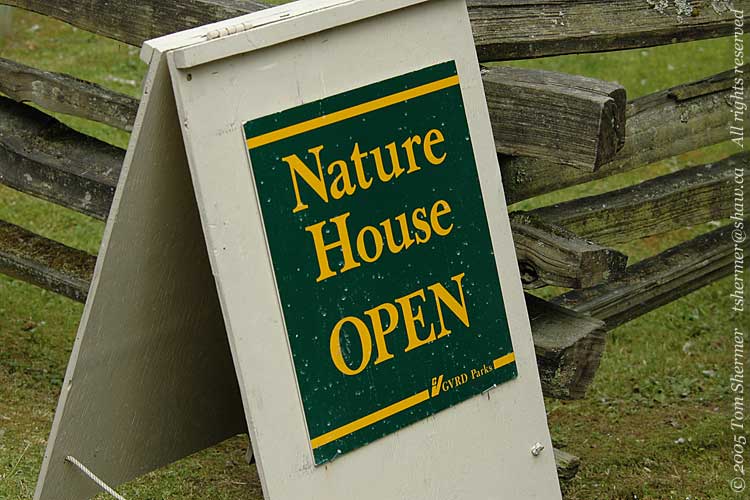 |
|
I went in, and as I
was the only customer, I chatted a little about the local wildlife
with the parks employee who was staffing the place. She was kind
and told me about some beavers that I've yet to find, a mixed-species
pair of teals that seemed to be nesting in the area, an eagle's
nest across the lake, and about having seen a Purple Martin fly
over the day before.
It was a nice little
chat, but I had birds to chase and so I bid her adieu and headed
out to the spit. The first bird I noticed was Lulu, who was resplendent
despite the greyness of the day.
|
|
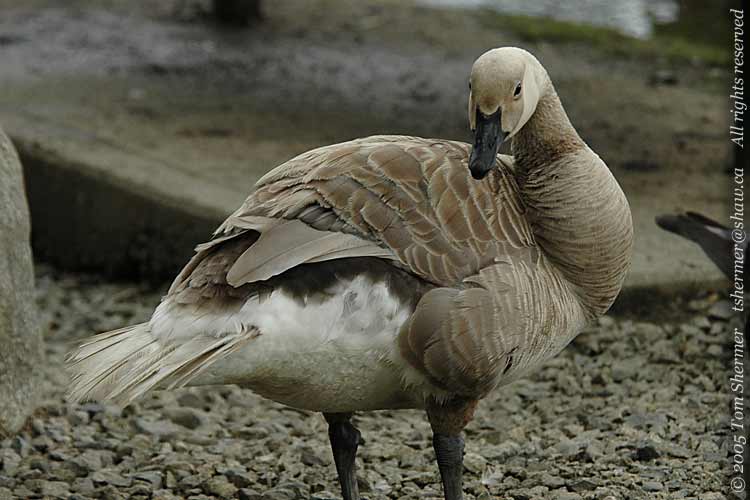 |
|
She was watching me
carefully, as a pair of her kids were sitting nearby. In the next
photo, I caught the kids with their eyes closed, but in general
they weren't really keeping their eyes closed or settling down
to rest.
On the right one you
can see what appears to be two wing feathers coming in; I've read
that this is a rather uncomfortable process for birds. Maybe that's
why these little ones were a little restless.
|
|
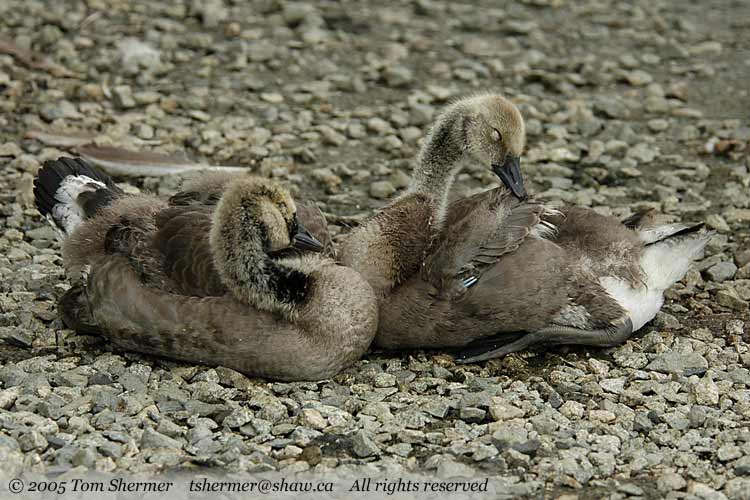 |
| To my left,
a female Red-winged Blackbird landed and was walking around, investigating
all the stuff on the ground. |
|
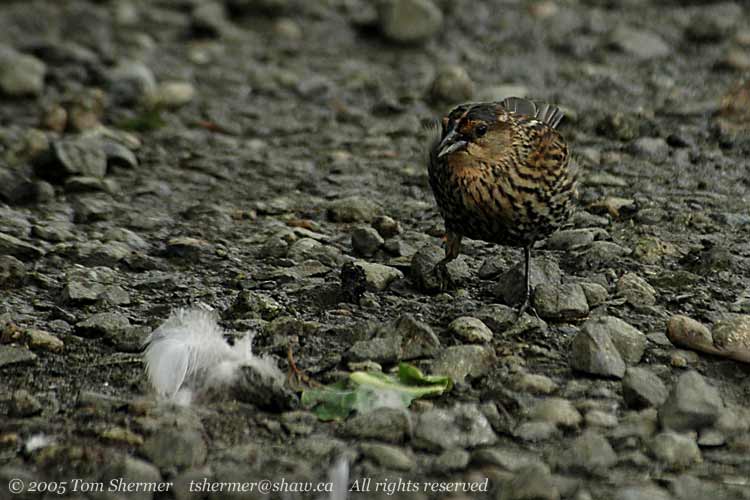 |
| And then
on my right, a Douglas' Squirrel came up to check me out. He was
thinking that I had brought peanuts; those Dougs are a pretty optimistic
bunch. |
|
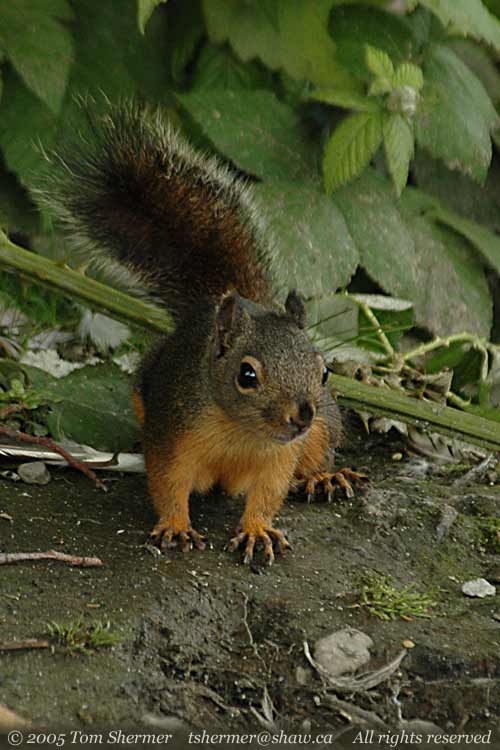 |
| After this
particular Doug gave up and scampered away, I walked a bit further
out the spit. From where I next stopped I could see a group of swallow
nest boxes that had been erected across the water in a marsh. They
were fairly far away, but I took a few shots of Tree Swallows on
the boxes. This one shows one on the front box and one going into
the back box. |
|
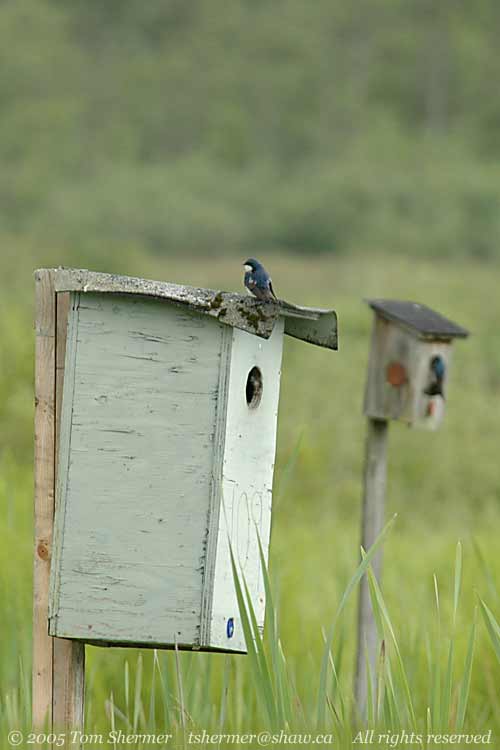 |
| Soon, a
male Red-winged Blackbird came and landed on the wooden rail about
two meters from me. I was a bit surprised that he had come so close;
normally they'll stay a little farther away. According to my camera,
he was there for about fifteen seconds; I got thirteen photos of
him. |
|
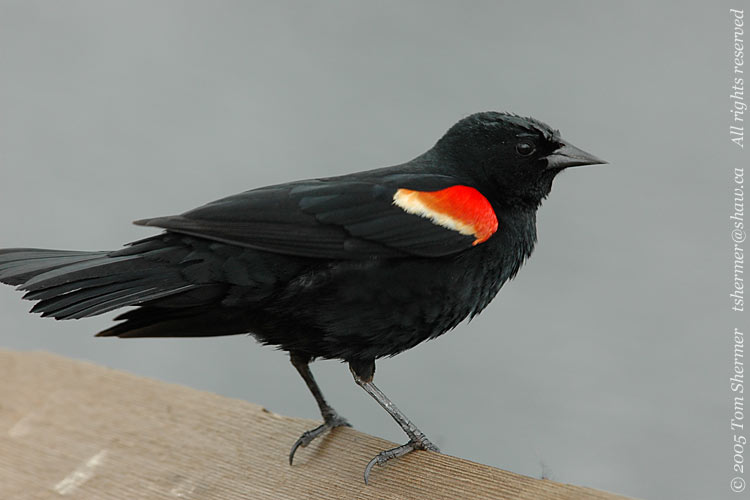 |
| After reaching
the end of the spit and finding not very much interesting out there,
I headed back in to land. Just off of the boardwalk, I found a Song
Sparrow doing that thing for which he is named. |
|
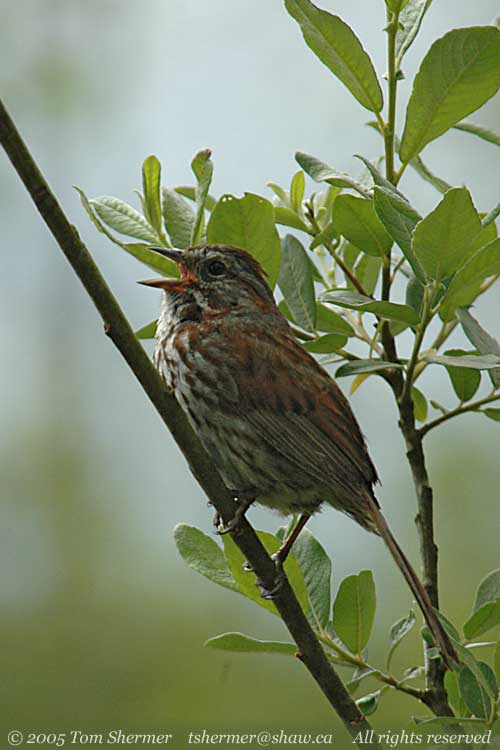 |
|
That was it from the
spit. I've vaguely known that, aside from the spit and the equestrian
paths, there were a few other entrances to the park around the
lake, particularly ones on the southwest side. This day I resolved
to go find at least one of them and check it out. So I drove around,
keeping the lake on my right, and eventually found a well-marked
park entrance at the Rowing Pavillion.
The Rowing Pavillion
is a place where folks who want to put their rowboats in the water
can do so. I don't think it's intended for your basic I-wanna-go-fishin'
rowboats, but rather for high-society rowing: sweeping
or sculling, crew or dragonboat racing.
Waterlillies coated
the water near the pavillion, and I started off with a few shots
of them. Here's one I particularly liked, both for the vivid color
and for the bugs I got in the shot.
|
|
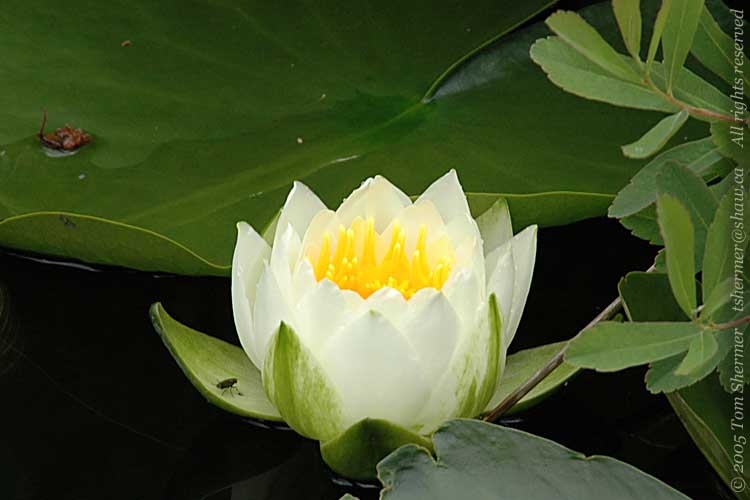 |
|
At the Rowing Pavillion,
there is a set of fairly decrepit bleachers, and on the back of
the bleachers, there are a number of small swallow nestboxes.
Many (if not all) of them were in active use by Tree Swallows.
I parked myself by the first box and took a slew of photos as
the swallow couple came and went, catching and bringing food to
their young'uns.
Here's one of my shots,
showing a little swallow with its mouth open (gaping),
hoping the adult perched on the outside will give it some food.
I only got a few shots showing the child gaping like this.
|
|
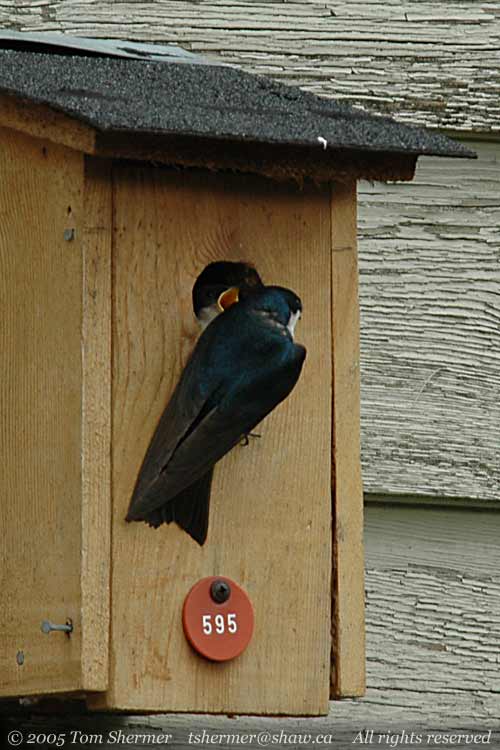 |
| When adults
came by, sometimes they would stay outside of the box, as above,
and sometimes they would go into the box. The next photo shows an
adult sticking its head out of the box, looking around. |
|
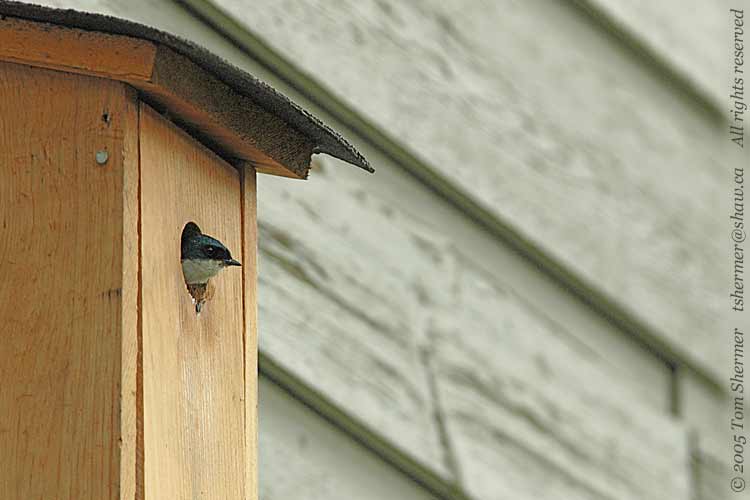 |
| Everything
outside seemed to be his satisfaction, because he then ventured
on out to get some more food for the kids. |
|
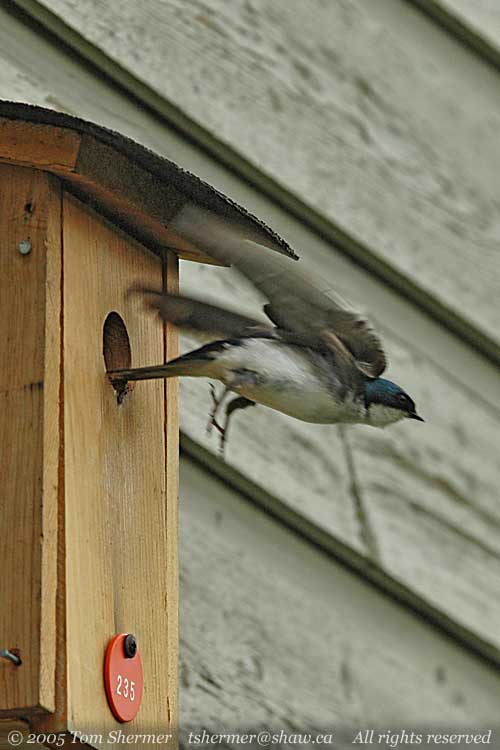 |
| The main
hunting ground for the swallows seemed to be over the lilypads.
Here's one cruising around, looking for a good bug. |
|
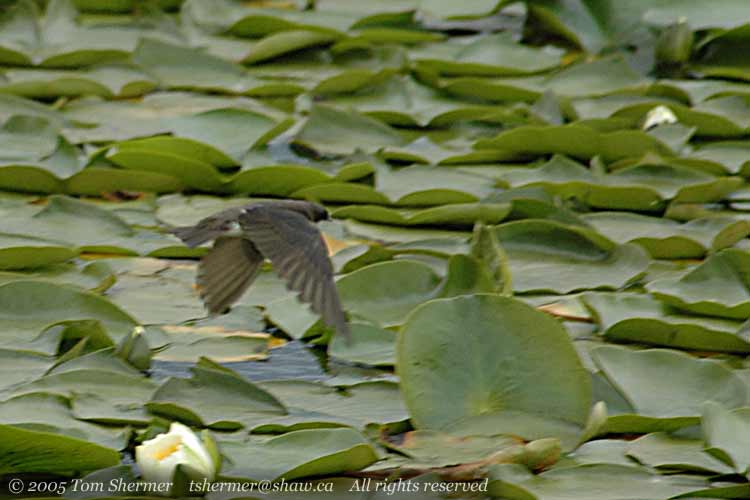 |
|
I walked around the
bleachers and through a corridor in their middle. When I got back
near where the pavillion is, I noticed a little silvery spider
near a crack in the wood on the side of the bleachers.
|
|
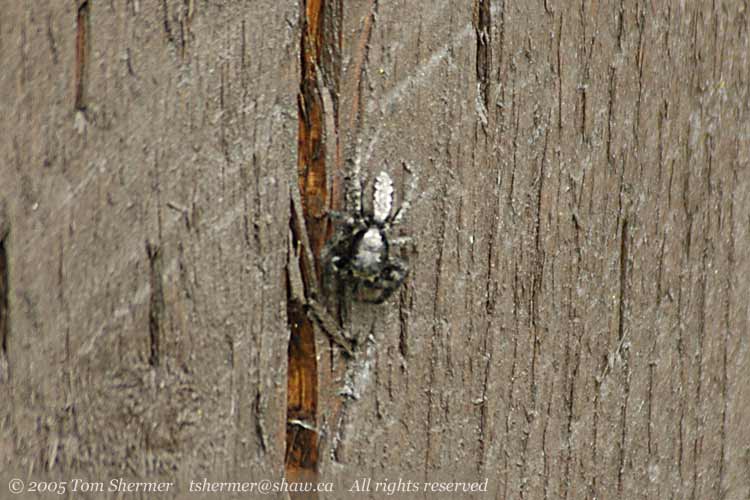 |
|
Life is sometimes odd
and full of coincidences, and when I went to figure out what kind
of spider this is, I discovered that it's a Jumping Spider. I've
done about a year of photojournals (a little more if you count
the emails that eventually evolved into the photojournal) without
seeing a jumping spider, and then, on the same day, I see two
different jumping spider species in entirely unrelated places.
Go figure.
I had thought that
this silver spider was a Playcryptus undatus, but Wayne
the Jumping Spider Guy tells me that its the closely-related Platycryptus
californicus. It turns out that P. undatus is bigger
and lives in the east.
That was it for the
Rowing Pavillion, and I jumped back into my car and headed around
the lake some more. Eventually, at the end of the road, I came
to another park entrance, known as the Glencarin Trailhead entrance.
It's just a parking lot and a trailhead. I parked and headed out
eastward along the trail.
It was quite a nice
trail that weaved through the woods, sometimes in view of the
lake and sometimes not. At one place, where I had a nice view
over a marsh to the lake, I saw a Woodpecker on one of the snags
in the marsh.
|
|
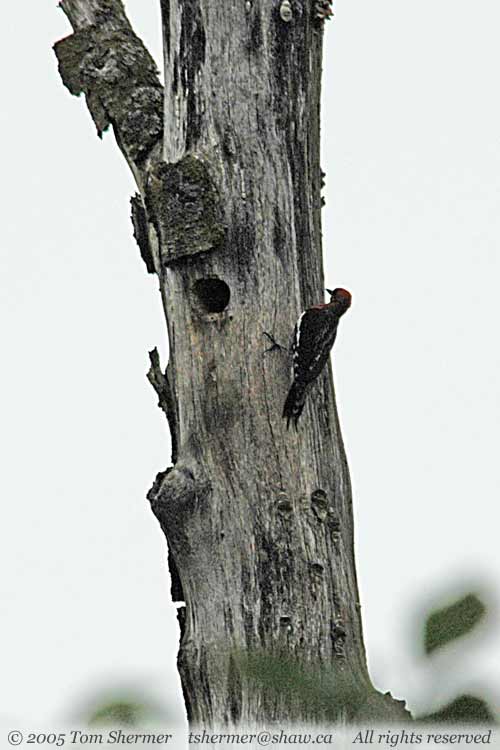 |
| Due to the
bad lighting conditions and the distance from the trail to the snag,
I wasn't able to get any great photos of the beast, but at least
I was able to tell that it was a Red-breasted Sapsucker. I'd heard
that there were sapsuckers in the park, but I'd never seen one there
before. |
|
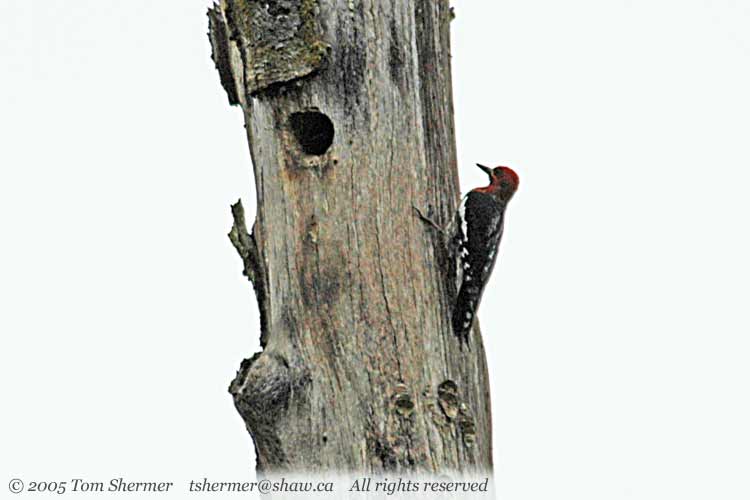 |
|
I don't know if that
hole on the snag was his home. I didn't see him go in there.
The next bird that
I found was a Bushtit who, like Lulu and the Tree Swallows, was
busy taking care of his kids. It looks like this guy's children
are in for a nice, juicy little grub.
|
|
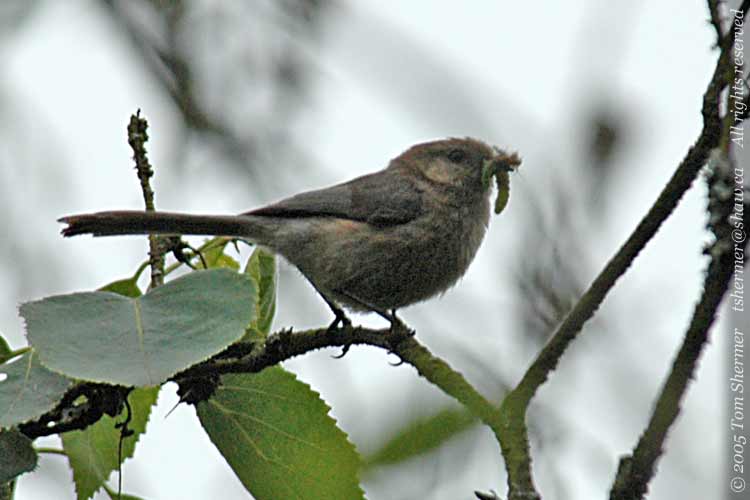 |
|
Thinking that I could
use a little grub myself, I turned around and headed back towards
my car. The only thing that deterred me from this mission was
the call of a Swainson's Thrush. When I heard that call, I looked
around, and was surprised to find the thrush on a tree limb that
was not only relatively out in the open, but also quite nearby.
I took advantage
of the opportunity he presented and shot a few portraits of him.
He cut quite a dashing figure, don't you think?
|
|
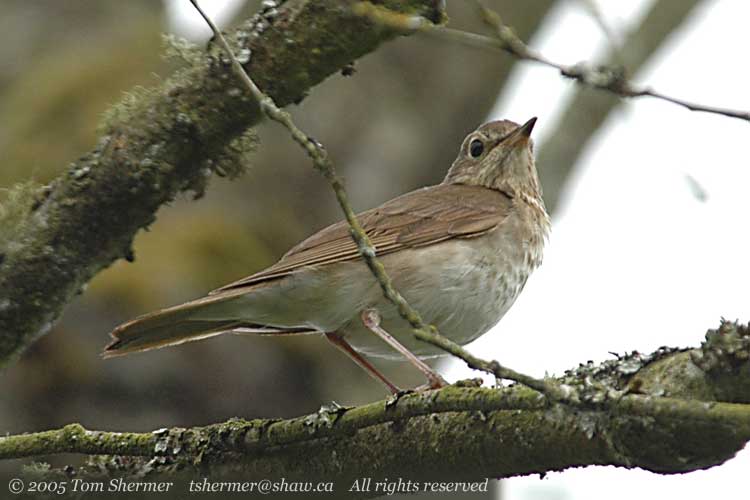 |
|
He was my last subject
of the day, and I made it back to my car without further encounters.
Grubbing for photos,
so that you don't have to,
Tom
|
|
|